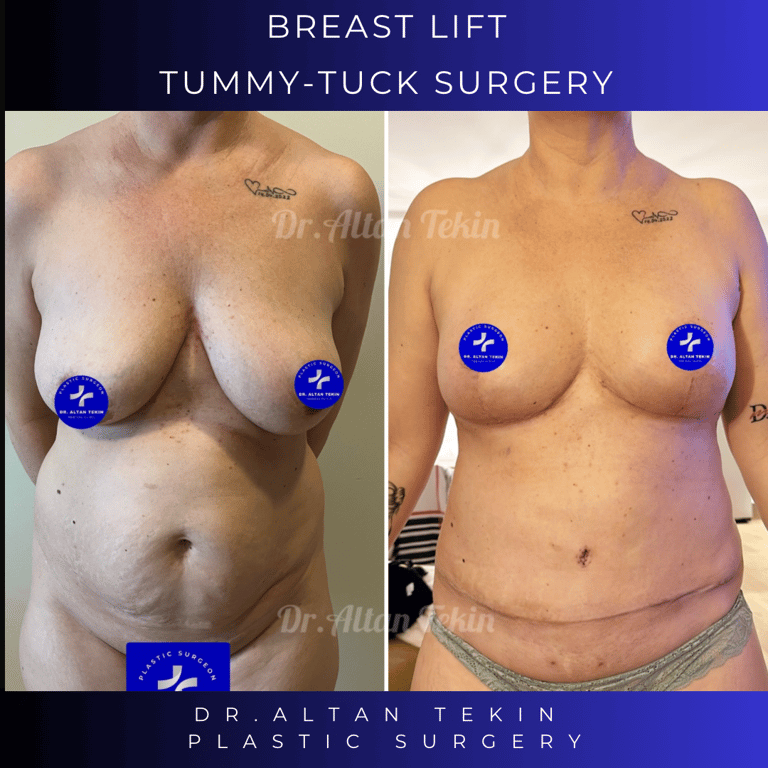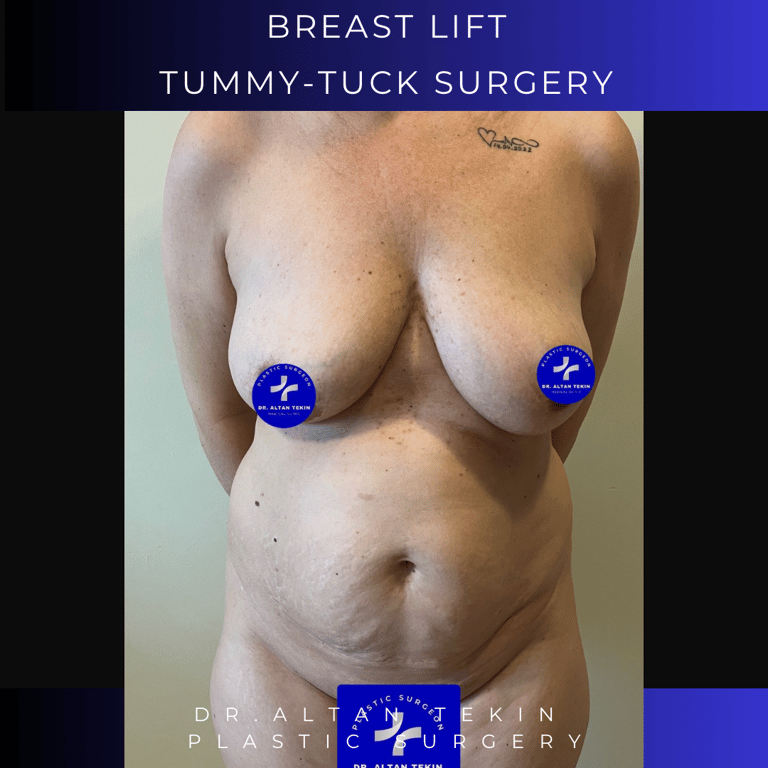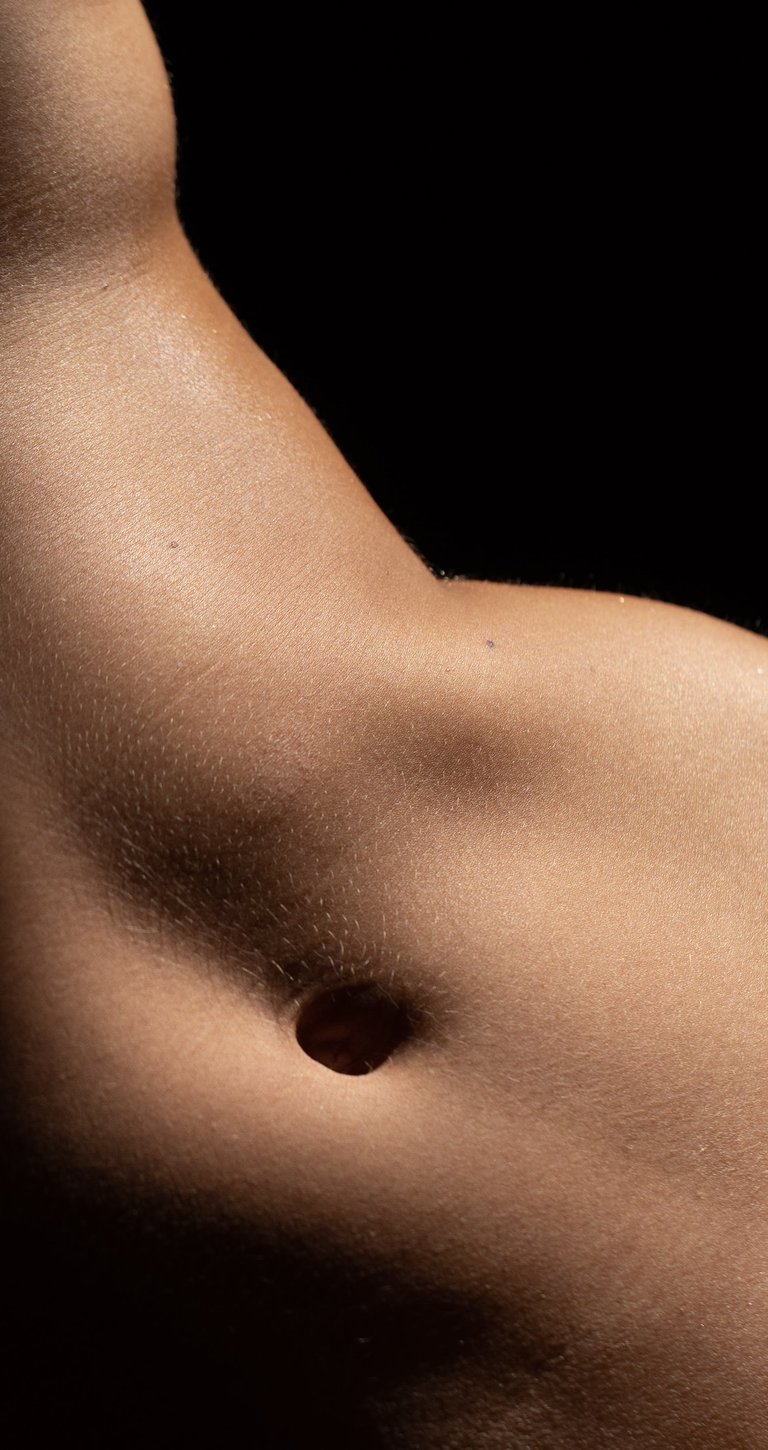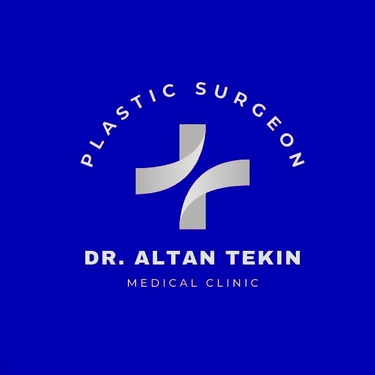CONTACT US: +90 544 138 84 64
ABDOMINOPLASTY
The best plastic surgeon at tummy tuck / abdominoplasty in Antalya.




What is abdominoplasty? Who is it done for? How To?
Abdominoplasty is a plastic surgery procedure also popularly called tummy tuck surgery. The main purpose of this surgery is to correct sagging, excess skin and fat tissues in the abdominal area and to tighten the abdominal muscles. Abdominoplasty is generally preferred to correct aesthetic problems in the abdominal area due to weight loss, pregnancy or aging.
The following steps are generally followed during abdominoplasty surgery:
Making Incisions: Incisions appropriate to the surgery area are made to remove excess skin and fat tissue in the abdominal area. Incisions are usually made along the bikini line so scars can be more easily hidden.
Removal of Skin and Fat Tissue: Excess skin and fatty tissue are removed. This step helps the abdominal area gain a tighter and smoother shape.
Tightening of the Abdominal Muscles: The muscles that form the abdominal wall are tightened when necessary. This step helps the abdominal area gain a smoother and tighter appearance.
Skin Redesign: The cut skin is combined with the remaining skin and a new contour of the surgical area is created.
Closing the Stitches: The incisions are closed and stitches are placed.
In the post-abdominoplasty period, patients are generally satisfied with the results of the surgery, because the tightening and smoothing effect in the abdominal area is evident. However, there are a few important points to consider after surgery. It is important to rest in the postoperative period, move as recommended by the doctor, take care of the stitches and perform the specified checks regularly.
What are abdominoplasty techniques?
Abdominoplasty (tummy tuck surgery) can be performed using different techniques and approaches. The choice of technique is determined by factors such as the patient's abdominal condition, wishes, skin elasticity and general health. Here are some commonly used abdominoplasty techniques:
Full Abdominoplasty: In this method, a large incision is made along the bikini line and the excess fat tissue and skin under the skin are removed. At the same time, the abdominal muscles are tightened. Sagging and looseness in the lower abdomen are corrected. This method is preferred for patients with severe sagging and excess skin in the abdomen.
Mini Abdominoplasty (Mini Tummy Tuck): In this method, which is used in milder cases, a smaller incision is made, usually below the bikini line. Sagging and adipose tissue in the lower abdomen are slightly corrected, but less affect the upper abdomen. This method is suitable for situations requiring limited correction.
Modified Abdominoplasty: This technique is like the middle of full and mini abdominoplasty methods. An incision is made below the bikini line, excess skin and fat tissue in the lower abdomen are removed. Abdominal muscles can be tightened. This method is used for patients with moderate sagging and looseness.
Flap Abdominoplasty: This method is sometimes used after removing excess skin and adipose tissue, creating a "flap" (fold) under the skin that hangs over the upper abdomen. In this method, tissue movement is more and more complex.
Abdominoplasty with Liposuction: Liposuction (fat suction) technique can also be used during abdominoplasty. It can be preferred especially in cases where excess fat tissue needs to be corrected.
Endoscopic Abdominoplasty: In this minimally invasive method, surgery is performed with small incisions using endoscopic techniques. It has the advantages of a faster healing process and less scarring.
It is important to speak with a plastic surgeon to determine which abdominoplasty technique is best for you. In line with your skin structure, the nature of the problems in the abdominal region, and your post-operative expectations, the method to get the best results should be determined.


What should be considered after abdominoplasty?
There are a few important points to consider after abdominoplasty (tummy tuck) surgery. By following these recommendations, you can improve the outcome of the surgery, speed up the healing process and minimize the risks of possible complications. Here are some general recommendations you should pay attention to after abdominoplasty surgery:
Rest and Movement: Take care to get enough rest in the postoperative period. Avoid heavy physical activities and move as your doctor recommends.
Suture Care: If sutures have been used, maintain suture care as recommended by your doctor. Be aware of when the stitches will be removed.
Bandage or Clothing Use: Use special bandages or clothing as recommended by your doctor. This can support the healing process.
Medication Use: Regularly use pain relievers, antibiotics and other medications recommended by your doctor. It is important to keep pain under control.
Nutrition and Hydration: Pay attention to a healthy diet and make sure you drink enough water. This can support the healing process.
Smoking and Alcohol: Limit or quit smoking and alcohol use in the post-operative period if possible. This can positively affect the healing process.
Doctor Controls: Do not forget to go to the doctor's controls regularly after the surgery. Your doctor will monitor your recovery and make recommendations if needed.
Skin Care: Clean and care for the postoperative sutures and surgical scars as recommended by your doctor.
Recovery Time: Each patient's recovery process is different. Be patient and follow your doctor's recommended instructions.
Avoid Heavy Lifting: Avoid heavy lifting for the first few weeks. This is important to support the healing process.
Following your doctor's recommendations strictly in the post-operative period will help you to protect the outcome of the surgery in the best way possible and to minimize possible risks.


What are the complications of abdominoplasty?
Abdominoplasty (tummy tuck) surgery is a plastic surgery procedure that usually gives successful results. However, like any surgery, abdominoplasty has potential risks and complications. These risks may vary depending on factors such as the general health of the patient, the complexity of the surgery, surgical experience and technique. Here are some of the possible risks of abdominoplasty surgery:
Infection: As with any surgical procedure, there is a risk of infection at the surgical site. It is important to pay attention to the hygiene rules after surgery to minimize the risk of infection.
Bleeding: Bleeding may occur during or after surgery. Therefore, it is important to avoid heavy physical activities in the postoperative period.
Wound Healing Problems: There may be problems with opening at the seams, irregular healing or wound healing.
Scar Tissue Formation: There is a possibility of scar formation after abdominoplasty surgery. In some patients, scar tissue may be more prominent.
Tissue Loss: Tissue loss may occur during or after surgery. Although this is rare, it is possible.
Sensory Changes: Temporary or permanent sensory changes may occur in the skin or around the nipple after surgery.
Nipple Changes: Nipple position may change or sensory changes may occur during abdominoplasty.
Anesthesia Reactions: Reactions to the anesthesia used during the surgery may occur.
Hematoma (Blood Clot): Blood clots can form at the surgical site in the postoperative period.
Necrosis (Tissue Death): Tissue death (necrosis), which is a rare complication, can usually occur due to nutritional problems of the skin or underlying tissue at the surgery site.
Asymmetry: Postoperative asymmetry (unsymmetrical appearance) problem may occur in the abdominal region.
Expectation of Aesthetic Results: Although abdominoplasty usually gives positive results, the aesthetic expectations of the patient may not be fully met.
Most of these risks are rare and can be minimized with the experience of a good surgical team and the use of appropriate techniques. Your surgeon performing the surgery will evaluate your specific health condition and explain the potential risks and complications before the surgery.


What you need to know about your tummy tuck recovery
A tummy tuck is a common plastic surgery procedure that has remained popular for years. In fact, the most recent statistics from the American Society of Plastic Surgeons show that this was one of the top five cosmetic procedures performed for men and women last year.
Despite the popularity of this surgery, many people often don't know what to expect during their recovery. Understanding the recovery process and timeline can help make the tummy tuck an easier journey for many patients.
Recovery times vary
There is no single answer for how long it will take to recover from a tummy tuck. Like any surgical procedure, there is a general time frame, but individual recoveries are based on a variety of factors, including the following:
Age
General health
Type of tummy tuck
Post-surgery care
After the procedure is complete, your surgeon will discuss a more specific timeline for your recovery, but generally speaking, most patients begin feeling more normal around the eight-week mark.
Why the type of tuck matters
There are several types of tummy tucks that can be performed. You can get a full or more involved "extended tummy tuck," or you can get a "mini" tuck, which only focuses on a small area in the lower abdomen.
The more extensive your abdominal contouring is, the longer it may take to recover fully. This is especially true if you opt for an extended tummy tuck because these can involve the flanks, lower back and lower chest.
What to expect during tummy tuck recovery
The most important thing to remember during this process is that you should follow your surgeon's instructions closely. Don't hesitate to contact the doctor's office if you have questions or concerns.
Choosing a board-certified plastic surgeon for your tummy tuck is always recommended because he or she has met stringent training and safety requirements that other surgeons have not. Your board-certified plastic surgeon can offer recovery advice and assistance throughout the healing process.
1. Immediately after surgery
Directly following a tummy tuck, your abdomen will be covered with surgical dressing. In many cases, there will be thin, small tubes placed around your incision in order to drain any fluid that builds up around it. This is common and shouldn't cause you any additional discomfort.
You will need to rest at an angle for the first few days of recovery and will be given instructions to move about to help prevent any blood clots.
2. When you're home
It's important to line up help for at least the first day or two that you're home following surgery. You will be prescribed pain medications and have somewhat limited mobility, so you will not be able to drive yourself home.
Once home, you will likely have difficulty with bending, lifting or standing for prolonged periods of time, so having someone to help around the house during the initial period after tummy tuck surgery can make recovery significantly easier.
3. Daily maintenance
Your doctor will teach you how to properly care for your incision and drainage tubes for the duration of your recovery.
Most patients are given antibiotics and anticoagulants to take for a certain length of time, and some are given topical creams to apply around the incision site.
You will have an abdominal support garment or wrap that will help with swelling and discomfort during recovery, so it's important to wear it for the recommended amount of time each day.
Smoking and drinking alcohol can seriously inhibit your recovery, so they should be avoided for at least three months post-surgery.
4. Resuming normal life
If you have young children, you will want to enlist help to assist with childcare, as squatting or picking up children (or heavy objects for that matter) for the first few weeks is strongly advised against. However, driving, cooking or shopping is often manageable after a week or two.
Most people opt to take up to a month off work for recovery. If you have a physically demanding job, it's especially important to take plenty of time off so that you don't jeopardize your recovery. You will also want to avoid exercise during this time for the same reasons.
5. Long-term effects
Some people experience numbness or a pulling sensation for weeks or months after a tummy tuck, but this is typically normal and often fades with time. It can take up to three months for the swelling and bruising to go down completely, and it may take longer than that for your scar to fade.
Recovery times vary
There is no single answer for how long it will take to recover from a tummy tuck. Like any surgical procedure, there is a general time frame, but individual recoveries are based on a variety of factors, including the following:
Age
General health
Type of tummy tuck
Post-surgery care
After the procedure is complete, your surgeon will discuss a more specific timeline for your recovery, but generally speaking, most patients begin feeling more normal around the eight-week mark.
What is diastasis recti? And how can a tummy tuck help?
Pregnancy and childbirth are all about new experiences and discoveries – even if this isn't your first baby. No matter how well you research and prepare, there will always be something that catches you by surprise. For many women, the condition that surprises them is diastasis recti.
Diastasis recti is a condition where the abdominal muscles separate down the middle of the stomach. While anyone can develop this condition, it is most often seen in women who are or have been pregnant. This is because the separation is one way the body can make room for the growing baby and uterus.
While this sounds like an abnormality, in truth, this separation is considered a normal part of pregnancy. Between the two columns of muscles that make up your abdominals, there is some connective tissue called the linea alba. This tissue is meant to stretch while pregnant, allowing the muscles to pull apart. Then, after birth, it tightens back up, pulling the muscles back together.
However, this condition only becomes concerning if a separation greater than 2.7 centimeters remains six or more weeks after birth. Even at that point, it is possible that the issue will resolve itself naturally or with the help of a little exercise.
The frequency of diastasis recti
Despite not being talked about much, diastasis recti is an incredibly common condition. The majority of mothers will have it to some degree. For roughly half of these women, the condition will resolve on its own within 12 months of delivery.
However, it is believed that many cases of diastasis recti go undiagnosed. It is essential that more mothers become aware of the condition so they can watch for the signs and get the treatment they need.
Health problems associated with diastasis recti
OThe most noticeable symptom of diastasis recti is a distended stomach. While this is mostly a cosmetic concern, there are real health problems that diastasis recti can cause. Weakened abdominal strength and a lax abdominal wall can both contribute to the following conditions:
Indigestion
Back pain
Stress incontinence
Hernia
If you notice any of these problems, you should check to see if you have diastasis recti.
How to test for diastasis recti
UThe only way to get an official diagnosis is to work with a medical professional. However, you can perform an at-home test to help you determine if you would feel better making an appointment now.
This at-home self-checkup is pretty easy. Just complete the following steps:
Lay on your back on a solid surface, such as the floor. Your bed is not firm enough to be a good surface.
Bend your knees.
Curl your chin towards your chest, engaging your abdominal muscles in a crunch position.
Use your fingers to locate the linea alba. Start at your belly button and move your fingers above it, following a vertical line.
As you move your fingers, try to press down gently. If you are able to, this could indicate ab separation.
Assuming you were able to push your abdomen down, try again and see if you feel tension or if your fingers are easily able to "sink" in.
If you find that they sink in easily, check to see how wide the gap is. One finger width is considered normal. More than one indicates there could be an issue.
Treatment for diastasis recti
Multiple treatment options are available for diastasis recti, including at-home exercises, physical therapy and surgery.
Typically, you will attempt exercise and physical therapy first. Even if these do not fully correct the problem, they will help position you to achieve better results from surgery and make the process less invasive. If these fail to deliver the right results, you move on to getting surgery to bring the abdominal muscles back together.
While often thought of as cosmetic, the surgery you would get is a tummy tuck for muscle repair. For a tummy tuck includes muscle repair, the surgeon can still remove excess skin and fat. However, they will also suture the connective tissue between the rectus muscles, pulling them closer together.
When compared to an aesthetic tummy tuck, this involves more complexity, increasing the cost and recovery time. However, if you have health insurance, the procedure should be covered, at least in part, by your provider.
How you choose to approach this surgery is up to you. If you are only interested in muscle repair, your surgeon can stick to that, but they can also offer a more comprehensive tummy tuck or make it part of an entire mommy makeover.
With that said, your first step is diagnosis. Talk to your doctor about your diastasis recti concerns.
Your guide to a tummy tuck – before, during and after
Has significant weight loss or pregnancy left you with loose skin or separated abdominal muscles? If you're looking for a way to restore your waistline and your confidence, a tummy tuck – also known as abdominoplasty – could be the solution you've been looking for.
This popular procedure removes excess skin and fat and tightens your abdominal muscles, giving you the toned, flat stomach you desire. But what exactly is a tummy tuck, and is it right for you? This guide will tell you what to expect before, during and after tummy tuck surgery
Before surgery: Deciding if it is right for you and finding the right surgeon
Understanding the procedure, what it can accomplish for you and how to choose a surgeon are essential first steps.
What is a tummy tuck?
A tummy tuck is a surgical procedure that removes excess skin and fat from the abdominal area while tightening the muscles. Different types of tummy tucks are available, including mini, full and extended. The right procedure for you will depend on your needs and aesthetic goals.
Who makes an ideal candidate for the procedure?
While a tummy tuck can be a life-changing procedure for many, it's not suitable for everyone. Ideal candidates are often people who have experienced significant weight loss or pregnancy and have excess skin, stretched or separated muscles and stubborn fat in the abdominal area that hasn't responded to diet and exercise. To achieve the best results, you should be at or near your goal weight before surgery.
How can you find the right surgeon for my tummy tuck surgery?
It's important to do your research when choosing a surgeon. Look for a board-certified plastic surgeon with extensive experience in tummy tuck surgery. Check their credentials, ask for referrals, read reviews from other patients and review before and after photos of their work.
Once you've narrowed your choices, schedule a consultation with your chosen surgeon to discuss your goals and concerns. Good communication between patient and surgeon is key to getting your desired results.
The ASPS Find a Plastic Surgeon referral service is an excellent resource for finding an ASPS Member Surgeon in your area.
How much does the procedure typically cost? Does insurance cover it?
The cost of a tummy tuck varies depending on factors such as the type of abdominoplasty performed, the surgeon's experience and your geographic location. . While insurance usually doesn't cover tummy tucks, financing options are often available.
How can you prepare for a tummy tuck?
Preparation for a tummy tuck can include quitting smoking several weeks in advance, eating a healthy, balanced diet and avoiding certain medications. Your plastic surgeon will provide you with specific instructions.
You'll need to arrange for someone to drive you home after the surgery and stay to assist you for the first several days of your recovery
During surgery: How it works and what to expect
Let's look closer at how a tummy tuck works and what you can expect during surgery.
How does a tummy tuck work?
A tummy tuck is performed under general anesthesia and typically takes between two to four hours, depending on the extent of the procedure. The surgeon makes an incision that enables the removal of excess skin and fat while tightening the abdominal muscles. The skin around the belly button will also be reshaped during a full tummy tuck.
What happens during tummy tuck surgery?
Here is a step-by-step breakdown of what you can expect during a tummy tuck procedure:
Anesthesia: Before the surgery begins, you'll be given general anesthesia to ensure you are asleep and pain-free during the procedure.
Incision: Once you're under anesthesia, your surgeon will make the necessary incisions. For a full tummy tuck, the incision will be made from hip bone to hip bone.
Muscle repair: After the incisions are made, the surgeon will repair the abdominal muscles, if necessary, tightening them to improve the contour of the area.
Excess skin and fat removal: The surgeon will remove any excess skin and fat from the abdominal area using excision (skin), liposuction (fat) or other techniques.
Belly button repositioning: If you're undergoing a full tummy tuck, your surgeon may reposition your navel for a more natural appearance after the surgery.
Closure: Once the necessary changes have been made, the surgeon will close the incisions using sutures or other techniques.
Recovery: After surgery, you'll be taken to a recovery area, where you'll be monitored as you wake up from the anesthesia. In most cases, you can return home the same day.
After surgery: Recovery and results
Knowing what to expect while healing from tummy tuck surgery helps you understand how to prepare for your recovery.
How long is the recovery period?
Recovery from tummy tuck surgery can take several weeks. Here's a general timeline of what you can expect during your recovery:
Week 1: You'll experience some pain and discomfort, which can be managed with medication. You may have drains in place to remove excess fluid from the surgical site, and you'll return to your surgeon's office for a follow-up visit. To reduce swelling and promote healing, you'll continuously wear a surgical body-shaping garment for the first two weeks and then as much as possible for another month. Light walking is encouraged to promote circulation, but your focus should be on getting plenty of rest.
Week 2: You should start to feel better and move around more comfortably. Some patients will be able to return to work and light daily activities.
Week 4: You should be able to resume most of your usual activities.
Week 6: Subject to your doctor's approval, you may be able to resume more strenuous exercise.
Since every patient's recovery timeline differs, follow your surgeon's instructions for your specific case.
What sort of scarring can you expect afterward?
Scarring is a common side effect of any surgery. However, you can minimize the scarring from tummy tuck surgery with proper care and follow-up.
The size and location of your scars will depend on the type of tummy tuck surgery you have. For a full tummy tuck, the scar typically extends from hip bone to hip bone and around the navel. A skilled surgeon will make the hip-to-hip incision straight and as low as possible so that underwear or swimsuit bottoms easily conceal the scar.
The scars will be visible for several months after the surgery but typically fade over time. Your surgeon will provide specific instructions for scar care and may recommend scar-minimizing treatments such as silicone sheets or gels.
What kind of results can you expect after the procedure?
It's important to have realistic expectations. While a tummy tuck can remove excess skin and fat and tighten the abdominal muscles, it's not a weight loss procedure nor a substitute for a healthy lifestyle.
The full results of a tummy tuck may take several months to fully appear as the swelling subsides and the incisions heal. To maintain your results, avoiding significant weight fluctuations is essential.
Tummy tuck surgery can be a transformative experience for patients, providing a smoother, more toned abdominal area that significantly enhances self-image and confidence.
The views expressed in this blog are those of the author and do not necessarily reflect the opinions of the American Society of Plastic Surgeons.
Modern tummy tucks can do more than ever before
The tummy tuck has come a long way since the first crude procedures were performed in order to treat wounds in the 1800s. Today's tummy tuck techniques not only offer safer and much more effective solutions, but also cut down on recovery and healing time and provide better results. Below are just some of the most notable advancements of the modern tummy tuck.
The drain-free tummy tuck
Prior to the drain-free tummy tuck technique, all tummy tucks were performed using a drain that prevented internal fluid buildup both during and after surgery. However, this made for a complicated recovery process, as the patient would need to empty the contents of the drain regularly before it was finally removed.
The drain-free tummy tuck eliminates the need for surgical and post-surgical drains by using a layered suture technique instead, leaving minimal extra space for fluid to build up. The result is not only a less complicated recovery but also a lower incision and less visible resulting scar.
The mini tummy tuck
Before the mini tummy tuck entered the plastic surgery scene, everyone who wanted to address any amount of sagging abdominal skin would need to opt for a full tummy tuck. Today, thanks to the mini tummy tuck technique, also called a partial abdominoplasty, plastic surgeons can now use a much smaller incision to tighten a small amount of excess skin below the belly button.
Tummy tucks as part of a mommy makeover
Tummy tucks are now very commonly paired with other cosmetic procedures, such as breast augmentation or liposuction, in what is called a mommy makeover. In a relatively short amount of time, a skilled plastic surgeon can safely and effectively perform multiple procedures at once, requiring anesthesia only once and a single recovery period.
Finding the best tummy tuck technique for you
Modern advancements in surgical tools and techniques have allowed for more tummy tuck options than ever before. Today, you can customize your tummy tuck procedure to best meet your specific needs and goals.
The best tummy tuck technique for you will depend on a number of factors, such as your natural anatomy, a physical examination and your goals for your final results. Equipped with this information, your plastic surgeon can help you decide which technique could be right for you.
